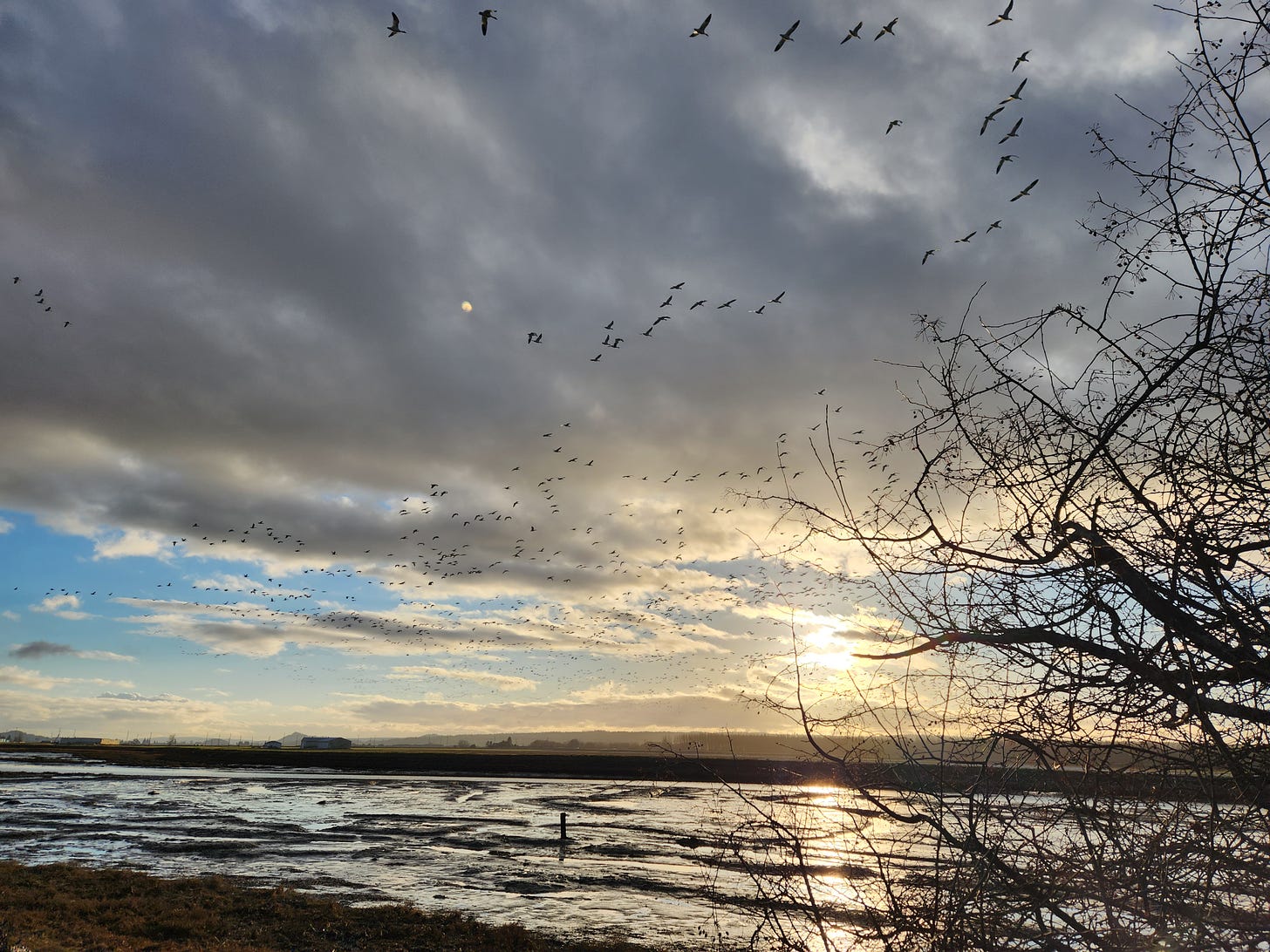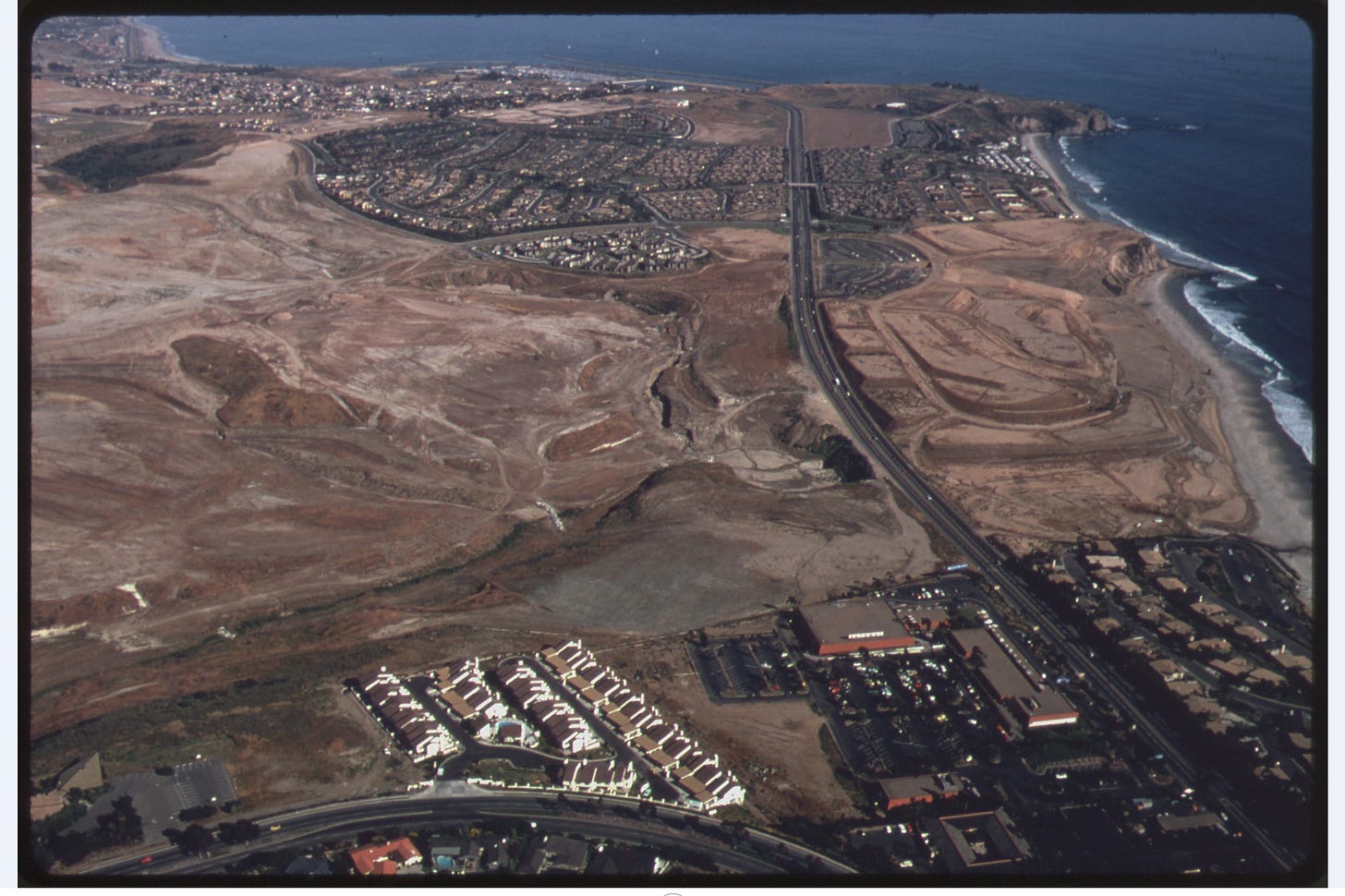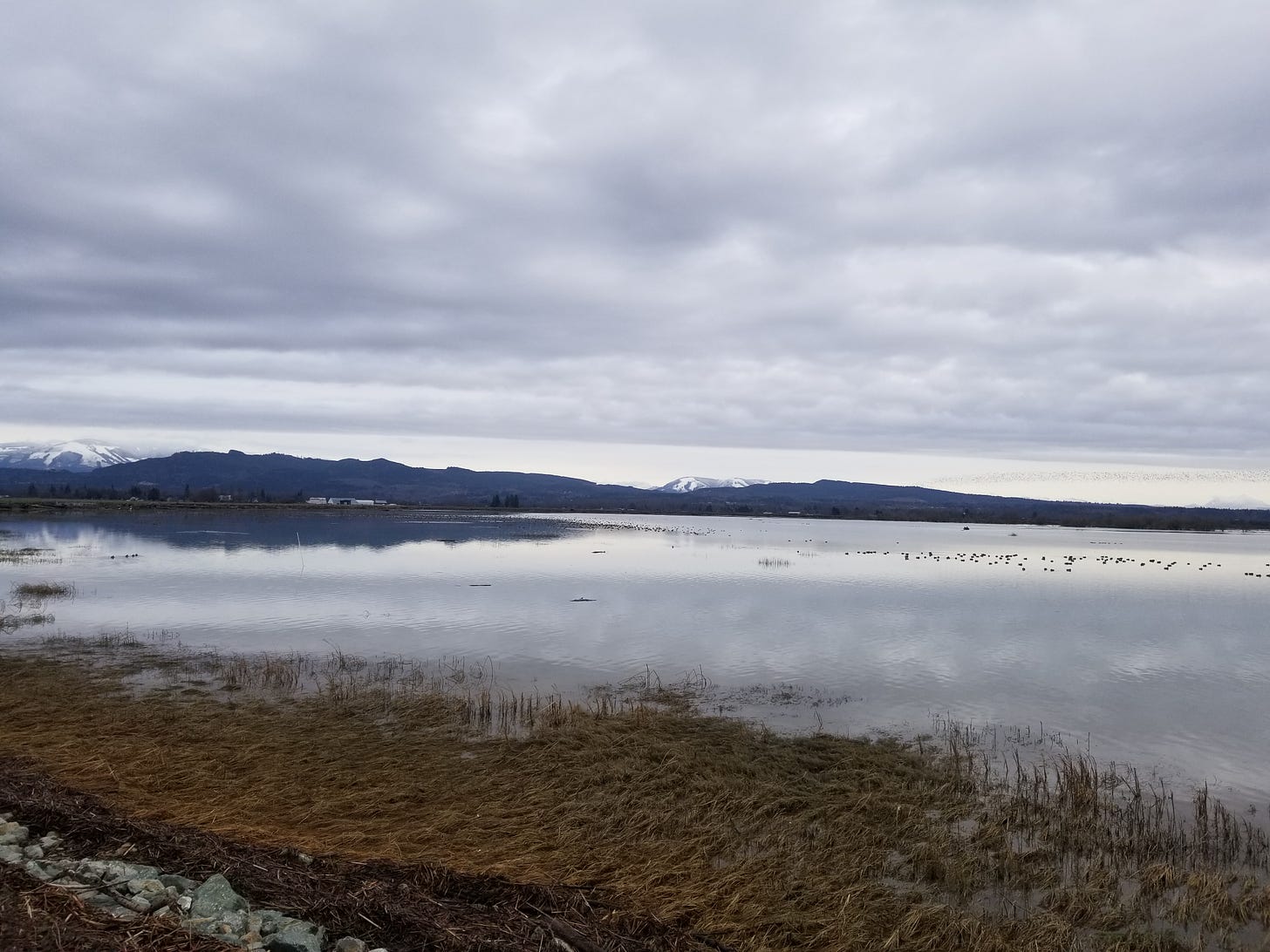Special Message about Subscriptions
Subscribers to Taking Bearings will note a new header this week. After experimenting with the newsletter for six months, I have decided to make a paid subscription option available. The weekly newsletter will remain free – along with all the archives – but if you would like to support this work, you may now upgrade to a paid subscription. It amounts roughly to a cup of coffee a month, and you’ll get occasional additional posts and my sincere gratitude. (There is also a founding member option that offers all the posts, archives, more gratitude, and a signed copy of one of my books.) If you’ve found Taking Bearings interesting or provocative or useful, I hope you will consider upgrading to a paid subscription.
Finding Wetlands
When I look west from my home, I see Fir Island, a wedge of farmland between the South Fork and the North Fork of the Skagit River. This low-lying island was diked and drained to create fields so that farmers could grow food (as I discussed briefly here). This process, often called reclamation, made nice farms but reduced wetlands dramatically, and wetlands furnish excellent habitat for waterfowl and other species (not to mention other ecological functions). Not surprisingly, waterfowl populations declined alongside the disappearance of wetlands.
One of the first places I connected to when I moved here was a small wildlife area on Fir Island at a reclaimed estuary. Here, a dike was breached, allowing the water to reclaim the land – a reversal of longstanding trends. At this spot, within sight on clear days of two of the Cascades’ volcanoes – Mount Baker and Mount Rainier – I learned firsthand about the remarkable bird life in the valley, especially migratory species like snow geese that I saw in the thousands. The implicit lesson is clear: improved wetland habitat meas improved bird populations.
Although I knew the general trajectory of declining wetlands and waterfowl and its halting improvements in recent decades, the policies that supported this change remained mostly unknown to me. By chance, I recently encountered a reference to the North American Waterfowl Management Plan of 1986 and then the North American Wetlands Conservation Act passed just three years later. Historians and conservationists do not herald the 1980s as a watershed for environmental legislation, so my curiosity was roused just in time for The Classroom week of the newsletter. I set out to learn something. Read on!

Background
Two parts of history are helpful to understand what preceded the changes begun in the 1980s.
First, wetlands disappeared. Practical human concerns dictated that wetlands be removed, especially with the practice of commercial agriculture and urban development. To qualify that statement: Indigenous peoples depended on wetlands and their rich diversity of life without requiring massive re-engineering. But colonial dreams and settlement traditions central to private property required that newcomers to the continent drain and dike and otherwise replace wetlands with predictably dry land. As technology evolved, the capacity to alter wetlands grew at large and alarming scales – bulldozers do more damage more quickly than shovels. By the mid-20th century, statistics overwhelmed. Between 1953 and 1982, wetlands decreased by 54% – and the 1953 starting point represented an already deeply drained continent. From the mid-1950s through the mid-1970s, just shy of half a million acres of wetlands were lost each year.1 The crisis mounted.
Second, environmental laws appeared. Outside of issues concerned specifically with wetlands or waterfowl, the 1960s and 1970s transformed American environmental law. Congress passed laws to designate wilderness, protect endangered species, control pollution, and plan developments more carefully and openly with input of scientists and citizens. Cumulatively, these laws – imperfect and incomplete as many find them today – utterly transformed how public land agencies, private industry, and real estate development operated. Predictably, these more stringent rules generated a strong backlash, something that helped propel Ronald Reagan to victory in 1980.
The Complicated Fate of Wetlands
Amid these upheavals, the US Fish and Wildlife Service (FWS) launched the National Wetlands Inventory in 1974. A decade later a report appeared, Wetlands of the United States: Current Status and Recent Trends, that documented the dire situation for wetlands. It ended in recommendations for both government and private landowners to change behaviors, for only in cooperation could a solution be forged.
One reason for that was the complicated nature of wetlands. The award-winning writer and historian Ann Vileisis explained it:
By virtue of their very nature, wetlands . . . challenged traditional concepts of property. Because the "wet" part of wetlands offered public benefits, the government had become involved to protect common values. Yet the "land" part had traditionally accorded owners the right to do what they wanted. Sooner or later Americans would have to address the apparent conflict between safeguarding environmental quality for society at large and preserving landowners’ rights. The wetlands were part land and part water, part private and part public.2
For a couple decades, environmental advocates had encouraged conservation agencies and laws to strengthen this public component, but the Reagan Administration tipped the balance heavily toward the private side.
Habitat kept disappearing. Wintering waterfowl populations kept plummeting.

Coordinating Solutions
Because migratory birds depend on far-flung landscapes in multiple jurisdictions, cooperation had long characterized management, at least as an ideal. Since the 1950s, the FWS coordinated with states in so-called Flyways Councils. The Canadian Wildlife Service operated similarly with provinces. By the 1980s, this coordinated work on the ground led to the idea that a larger, continental plan was necessary.3
The North American Waterfowl Management Plan was signed in 1986 after two years of negotiations by the US Secretary of the Interior and the Canadian Minister of the Environment. According to Vileisis in her definitive book Discovering the Unknown Landscape: A History of American Wetlands, this plan launched the largest landscape planning enterprise ever.4
The plan’s grand ambitions, however, were not matched by large budgets. The approach depended on joint public-private ventures and joint public and private funds. Conservation groups like Ducks Unlimited raised money and local groups worked to purchase habitat. Projects started to forge connections, but more was needed.
Congress stepped in with the North American Wetlands Conservation Act of 1989. Hardly controversial, it first was introduced in the Senate in April; it became law by December. Voice votes and unanimous consent pushed it rapidly through the legislative process. The law provided matching funds for projects. Effectively, this law funded the previous plan. Organizations could use these funds to acquire land or help with establishing conservation easements and similar measures meant to support wetlands and waterfowl.
Through a mishmash of plans and methods and funding sources, new ways for long-term planning and provisions for waterfowl and wetlands emerged during an otherwise inauspicious conservation moment. The lack of enthusiasm for conservation at the federal level in the 1980s meant local people and organizations fortified their connections and developed creative fundraising and rehabilitation projects.

Outlook, Looking Out
According to the most recent North American Wetlands Conservation Act Progress Report from 2018-19, the program has funded more then 2,900 projects in its three decades across more than 30 million acres. More than 6,100 partners have contributed $3.5 billion with the federal government granting $1.7 billion toward these efforts. The money goes to purchasing land, enhancing habitat, and helping to manage land for conservation values – sometimes this means keeping farms and ranches operating instead of selling for housing developments.
A small portion of those numbers represent work done close to me during that most recent funding cycle, and no doubt earlier cycles contributed to reclaiming wetlands in the estuaries and riparian areas close to home. I have yet to investigating funding sources for nearby projects (perhaps another newsletter later!).
When you check the report, there is a column for “duration” of the projects. The most frequent entry is “perpetuity.” That’s seems like a good start.
Final Words
My most recent book, Making America’s Public Lands, tells the story of the legal revolution of the 1960s and 1970s and the reaction against it. You can find it in the Bookshop link below. I summarized those trends in short pieces you can find here and here.
As always, you can find my books, and books where some of my work is included, at my Bookshop affiliate page (where, if you order, I get a small benefit).
Taking Bearings Next Time
The Field Trip is next in the cycle, and I’ve been getting out a little. I’m not sure which place to highlight or whether I’ll combine trips into one report. But you’ll see some more of the Northwest next week. Stay tuned and please consider sharing Taking Bearings with people who might enjoy it.
Figures are from Ann Vileisis, Discovering the Unknown Landscape: A History of America’s Wetlands (Washington, DC: Island Press, 1997), 273.
Vileisis, 274.
This was the same era when conservation biology brought together scientists and conservationists who developed other ideas about continental wide conservation programs, such as the proposed Northern Rockies Ecosystem Protection Act and the Yellowstone to Yukon Conservation Initiative.
Despite the North American moniker, Mexico did not join until 1994.



